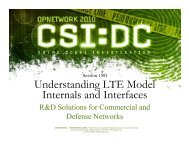Automated Axon Tracking of 3D Confocal Laser Scanning ...
Automated Axon Tracking of 3D Confocal Laser Scanning ...
Automated Axon Tracking of 3D Confocal Laser Scanning ...
You also want an ePaper? Increase the reach of your titles
YUMPU automatically turns print PDFs into web optimized ePapers that Google loves.
introduce another set <strong>of</strong> seed points that initiate the segmentation.We begin the analysis by finding the centers <strong>of</strong> the axons in the first cross-sectional slice.The centers <strong>of</strong> the axons traced in the MIP image can be easily found by searching for localintensity maxima in that slice. But, as seen in Figure 4, not all the axons are usually traced in theMIP image before encountering a cross-over. Therefore, the seed points for the rest <strong>of</strong> the axonsin the first image are identified manually. These serve as the initial seed points for the next slicein the dataset. The axon cross-sections in the current slice will most likely be shifted from theirpositions in the previous slice. So, the centers from the previous cross-section cannot be directlyused as seeds, and need correction. The mean-shift algorithm is used for this purpose.Mean-ShiftThe mean-shift makes use <strong>of</strong> the intensity information to find the seed points in the image. Itbasically tries to find the approximate center points by searching for the center inside a movingkernel, which is a disc shaped region. The kernel is first placed at the initial seed points obtaineddirectly from the previous cross-section. The center inside the kernel is calculated based on theweighted mean with the intensity as the weights. The seed point is then updated with the meancalculated in the current iteration. The kernel is now centered at the new seed point and thecomputation is repeated again until the algorithm converges or until the number <strong>of</strong> iterationsreaches a preset threshold.The mean shift algorithm fails when close-lying axons have a considerable difference in theirintensities. The algorithm tends to move towards the brighter axon in such cases, which results inseed point being placed near the edges or sometimes entirely outside the actual axon. This isshown in Figure 6(a) inside the yellow ellipse. The corresponding segmentation result usingseeded watershed algorithm is shown in Figure 6(b).15















